Modelling the Impact of Climate Change on Coastal Flooding: Implications for Coastal Structures Design
Abstract
1. Introduction
2. Model Description
2.1. The Large-Scale Wave Propagation Model (WAVE_LS)
2.2. The Storm-Induced Circulation Model (SICIR)
2.3. The Advanced Nearshore Wave Propagation Model (WAVE_BQ)
3. Model Validation
3.1. Coastal Flooding
3.2. Wave Transmission at Coastal Structures
4. Model Applications
4.1. Large-Scale Applications
4.2. Applications for Coastal Structures Design Evaluation
5. Results and Discussion
5.1. Large-Scale Applications
5.2. Applications for Coastal Structures Design Evaluation
5.3. General Discussion
6. Conclusions
Author Contributions
Funding
Institutional Review Board Statement
Informed Consent Statement
Data Availability Statement
Conflicts of Interest
References
- Mentaschi, L.; Vousdoukas, M.I.; Voukouvalas, E.; Dosio, A.; Feyen, L. Global changes of extreme coastal wave energy fluxes triggered by intensified teleconnection patterns. Geophys. Res. Lett. 2017, 44, 2416–2426. [Google Scholar] [CrossRef]
- Vousdoukas, M.I.; Mentaschi, L.; Voukouvalas, E.; Verlaan, M.; Feyen, L. Extreme sea levels on the rise along Europe’s coasts. Earth’s Future 2017, 5, 304–323. [Google Scholar] [CrossRef]
- Lobeto, H.; Menendez, M.; Losada, I.J. Future behavior of wind wave extremes due to climate change. Sci. Rep. 2021, 11, 7869. [Google Scholar] [CrossRef] [PubMed]
- Coelho, C.; Silva, R.; Veloso-Gomes, F.; Taveira-Pinto, F. Potential effects of climate change on northwest Portuguese coastal zones. ICES J. Mar. Sci. 2009, 66, 1497–1507. [Google Scholar] [CrossRef]
- O’Grady, J.G.; Hemer, M.A.; McInnes, K.L.; Trenham, C.E.; Stephenson, A.G. Projected incremental changes to extreme wind-driven wave heights for the twenty-first century. Sci. Rep. 2021, 11, 8826. [Google Scholar] [CrossRef] [PubMed]
- Kirezci, E.; Young, I.R.; Ranasinghe, R.; Muis, S.; Nicholls, R.J.; Lincke, D.; Hinkel, J. Projections of global-scale extreme sea levels and resulting episodic coastal flooding over the 21st Century. Sci. Rep. 2020, 10, 11629. [Google Scholar] [CrossRef] [PubMed]
- Bosello, F.; Nicholls, R.J.; Richards, J.; Roson, R.; Tol, R.S.J. Economic impacts of climate change in Europe: Sea-level rise. Clim. Chang. 2012, 112, 63–81. [Google Scholar] [CrossRef]
- Hanson, S.; Nicholls, R.; Ranger, N.; Hallegatte, S.; Corfee-Morlot, J.; Herweijer, C.; Chateau, J. A global ranking of port cities with high exposure to climate extremes. Clim. Chang. 2011, 104, 89–111. [Google Scholar] [CrossRef]
- Hinkel, J.; Lincke, D.; Vafeidis, A.T.; Perrette, M.; Nicholls, R.J.; Tol, R.S.J.; Marzeion, B.; Fettweis, X.; Ionescu, C.; Levermann, A. Coastal flood damage and adaptation costs under 21st century sea-level rise. Proc. Natl. Acad. Sci. USA 2014, 111, 3292–3297. [Google Scholar] [CrossRef]
- Izaguirre, C.; Losada, I.J.; Camus, P.; Vigh, J.L.; Stenek, V. Climate change risk to global port operations. Nat. Clim. Chang. 2021, 11, 14–20. [Google Scholar] [CrossRef]
- Vousdoukas, M.I.; Mentaschi, L.; Voukouvalas, E.; Bianchi, A.; Dottori, F.; Feyen, L. Climatic and socioeconomic controls of future coastal flood risk in Europe. Nat. Clim. Chang. 2018, 8, 776–780. [Google Scholar] [CrossRef]
- Rodriguez-Delgado, C.; Bergillos, R.J.; Iglesias, G. Coastal infrastructure operativity against flooding—A methodology. Sci. Total Environ. 2020, 719, 137452. [Google Scholar] [CrossRef] [PubMed]
- Wong, P.P.; Losada, I.J.; Gattuso, J.-P.; Hinkel, J.; Khattabi, A.; McInnes, K.L.; Saito, Y.; Sallenger, A. Coastal systems and low-lying areas. In Climate Change 2014: Impacts, Adaptation, and Vulnerability. Part A: Global and Sectoral Aspects. Contribution of Working Group II to the Fifth Assessment Report of the Intergovernmental Panel on Climate Change; Field, C.B., Barros, V.R., Dokken, D.J., Mach, K.J., Mastrandrea, M.D., Bilir, T.E., Chatterjee, M., Ebi, K.L., Estrada, Y.O., Genova, R.C., et al., Eds.; Cambridge University Press: Cambridge, UK; New York, NY, USA, 2014; pp. 361–409. [Google Scholar]
- Hubbert, G.D.; McInnes, K.L. A storm surge inundation model for coastal planning and impact studies. J. Coast. Res. 1999, 15, 168–185. [Google Scholar]
- Zokagoa, J.M.; Soulaïmani, A. Modeling of wetting-drying transitions in free surface flows over complex topographies. Comput. Methods Appl. Mech. Eng. 2010, 199, 2281–2304. [Google Scholar] [CrossRef]
- Barnard, P.L.; Erikson, L.H.; Foxgrover, A.C.; Hart, J.A.F.; Limber, P.; O’Neill, A.C.; van Ormondt, M.; Vitousek, S.; Wood, N.; Hayden, M.K.; et al. Dynamic flood modeling essential to assess the coastal impacts of climate change. Sci. Rep. 2019, 9, 4309. [Google Scholar] [CrossRef]
- Bates, P.D.; Dawson, R.J.; Hall, J.W.; Horritt, M.S.; Nicholls, R.J.; Wicks, J.; Ali Mohamed Hassan, M.A. Simplified two-dimensional numerical modelling of coastal flooding and example applications. Coast. Eng. 2005, 52, 793–810. [Google Scholar] [CrossRef]
- Gaeta, M.G.; Bonaldo, D.; Samaras, A.G.; Carniel, S.; Archetti, R. Coupled Wave-2D Hydrodynamics Modeling at the Reno River Mouth (Italy) under Climate Change Scenarios. Water 2018, 10, 1380. [Google Scholar] [CrossRef]
- Le Roy, S.; Pedreros, R.; André, C.; Paris, F.; Lecacheux, S.; Marche, F.; Vinchon, C. Coastal flooding of urban areas by overtopping: Dynamic modelling application to the Johanna storm (2008) in Gâvres (France). Nat. Hazards Earth Syst. Sci. 2015, 15, 2497–2510. [Google Scholar] [CrossRef]
- Li, N.; Roeber, V.; Yamazaki, Y.; Heitmann, T.W.; Bai, Y.; Cheung, K.F. Integration of coastal inundation modeling from storm tides to individual waves. Ocean Model. 2014, 83, 26–42. [Google Scholar] [CrossRef]
- McInnes, K.L.; Hubbert, G.D.; Abbs, D.J.; Oliver, S.E. A numerical modelling study of coastal flooding. Meteorol. Atmos. Phys. 2002, 80, 217–233. [Google Scholar] [CrossRef]
- Peng, M.; Xie, L.; Pietrafesa, L.J. A numerical study of storm surge and inundation in the Croatan-Albemarle- Pamlico Estuary System. Estuar. Coast. Shelf Sci. 2004, 59, 121–137. [Google Scholar] [CrossRef]
- Postacchini, M.; Lalli, F.; Memmola, F.; Bruschi, A.; Bellafiore, D.; Lisi, I.; Zitti, G.; Brocchini, M. A model chain approach for coastal inundation: Application to the bay of Alghero. Estuar. Coast. Shelf Sci. 2019, 219, 56–70. [Google Scholar] [CrossRef]
- Goda, Y.; Ippen, A.T. Theoretical and Experimental Investigation of Wave Energy Dissipators Composed of Wire Mesh Screens; Massachusetts Institute of Technology, Cambridge Hydrodynamics Lab: Cambridge, MA, USA, 1963; p. 66. [Google Scholar]
- Galani, K.A.; Dimou, I.D.; Dimas, A.A. Wave height and setup in the sheltered area of a segmented, detached, rubble-mound, zero-freeboard breakwater on a steep beach. Ocean Eng. 2019, 186, 106124. [Google Scholar] [CrossRef]
- Koutrouveli, T.I.; Dimas, A.A. Wave and hydrodynamic processes in the vicinity of a rubble-mound, permeable, zero-freeboard break water. J. Mar. Sci. Eng. 2020, 8, 206. [Google Scholar] [CrossRef]
- Papadimitriou, A.G.; Chondros, M.K.; Metallinos, A.S.; Memos, C.D.; Tsoukala, V.K. Simulating wave transmission in the lee of a breakwater in spectral models due to overtopping. Appl. Math. Model. 2020, 88, 743–757. [Google Scholar] [CrossRef]
- Zhang, S.X.; Li, X. Design formulas of transmission coefficients for permeable breakwaters. Water Sci. Eng. 2014, 7, 457–467. [Google Scholar]
- Formentin, S.M.; Zanuttigh, B.; Van Der Meer, J.W. A neural network tool for predicting wave reflection, overtopping and transmission. Coast. Eng. J. 2017, 59, 1750006-1. [Google Scholar] [CrossRef]
- Panizzo, A.; Briganti, R. Analysis of wave transmission behind low-crested breakwaters using neural networks. Coast. Eng. 2007, 54, 643–656. [Google Scholar] [CrossRef]
- d’Angremond, K.; Van der Meer, J.W.; de Jong, R.J. Wave transmission at low-crested breakwaters. In 25th International Conference of Coastal Engineering; ASCE: Orlando, FL, USA, 1996; pp. 2418–2426. [Google Scholar]
- van der Meer, J.W.; Briganti, R.; Zanuttigh, B.; Wang, B. Wave transmission and reflection at low-crested structures: Design formulae, oblique wave attack and spectral change. Coast. Eng. 2005, 52, 915–929. [Google Scholar] [CrossRef]
- Buccino, M.; Calabrese, M. Conceptual approach for prediction of wave transmission at low-crested breakwaters. J. Waterw. Port. Coast. Ocean Eng. 2007, 133, 213–224. [Google Scholar] [CrossRef]
- Goda, Y.; Ahrens, J.P. New formulation of wave transmission over and through low-crested structures. In Proceedings of the Coastal Engineering Conference, Hamburg, Germany; 2009; pp. 3530–3541. [Google Scholar]
- Tanaka, N. Wave deformation and beach stabilization capacity of wide crested submerged breakwaters. In 23rd Japanese Conference on Coastal Engineering; JSCE: Tokyo, Japan, 1976; pp. 152–157. [Google Scholar]
- Numata, A. Experimental study on wave attenuation by block mound breakwaters. In 22nd Japanese Conference on Coastal Engineering; JSCE: Tokyo, Japan, 1975; pp. 501–505. [Google Scholar]
- Tomasicchio, G.R.; D’Alessandro, F. Wave energy transmission through and over low crested breakwaters. J. Coast. Res. 2013, 398–403. [Google Scholar] [CrossRef]
- Roeber, V.; Cheung, K.F.; Kobayashi, M.H. Shock-capturing Boussinesq-type model for nearshore wave processes. Coast. Eng. 2010, 57, 407–423. [Google Scholar] [CrossRef]
- Booij, N.; Ris, R.C.; Holthuijsen, L.H. A third-generation wave model for coastal regions: 1. Model description and validation. J. Geophys. Res. Oceans 1999, 104, 7649–7666. [Google Scholar] [CrossRef]
- Holthuijsen, L.H.; Herman, A.; Booij, N. Phase-decoupled refraction–diffraction for spectral wave models. Coast. Eng. 2003, 49, 291–305. [Google Scholar] [CrossRef]
- Battjes, J.A.; Stive, M.J.F. Calibration and verification of a dissipation model for random breaking waves. J. Geophys. Res. Oceans 1985, 90, 9159–9167. [Google Scholar] [CrossRef]
- Battjes, J.A.; Janssen, J.P.F.M. Energy loss and set-up due to breaking of random waves. In Proceedings of the 16th International Conference on Coastal Engineering, Hamburg, Germany, 27 August–3 September 1978; pp. 569–587. [Google Scholar]
- Leont’Yev, I.O. Modelling of morphological changes due to coastal structures. Coast. Eng. 1999, 38, 143–166. [Google Scholar] [CrossRef]
- Koutitas, C.G. Mathematical Models in Coastal Engineering; Pentech Press: London, UK, 1988. [Google Scholar]
- Kobayashi, N.; Agarwal, A.; Johnson, B.D. Longshore current and sediment transport on beaches. J. Waterw. Port. Coast. Ocean Eng. 2007, 133, 296–304. [Google Scholar] [CrossRef]
- Madsen, P.A.; Rugbjerg, M.; Warren, I.R. Subgrid modelling in depth integrated flows. In 21st International Conference on Coastal Engineering; CERC: Terremolinos, Spain, 1988; pp. 505–511. [Google Scholar]
- Militello, A.; Reed, C.W.; Zundel, A.K.; Kraus, N.C. Two-Dimensional Depth-Averaged Circulation Model M2D: Version 2.0, Report 1, Technical Documentation and User’s Guide; ERDC/CHL TR-04-2; US Army Corps of Engineers, Engineering Research and Development Center: Washington, DC, USA, 2004; p. 134. [Google Scholar]
- Chen, H.; Jiang, D.; Tang, X.; Mao, H. Evolution of irregular wave shape over a fringing reef flat. Ocean Eng. 2019, 192, 106544. [Google Scholar] [CrossRef]
- Chen, Q.; Kirby, J.; Dalrymple, R.; Kennedy, A.; Chawla, A. Boussinesq Modeling of Wave Transformation, Breaking, and Runup.II: 2D. J. Waterw. Port Coast. Ocean Eng. 2000, 126, 48–56. [Google Scholar] [CrossRef]
- Pinault, J.; Morichon, D.; Roeber, V. Estimation of Irregular Wave Runup on Intermediate and Reflective Beaches Using a Phase-Resolving Numerical Model. J. Mar. Sci. Eng. 2020, 8, 993. [Google Scholar] [CrossRef]
- Roeber, V.; Cheung, K.F. Boussinesq-type model for energetic breaking waves in fringing reef environments. Coast. Eng. 2012, 70, 1–20. [Google Scholar] [CrossRef]
- Tang, J.; Zhao, C.; Shen, Y. Numerical investigation of the effects of coastal vegetation zone width on wave run-up attenuation. Ocean Eng. 2019, 189, 106395. [Google Scholar] [CrossRef]
- Tonelli, M.; Petti, M. Numerical simulation of wave overtopping at coastal dikes and low-crested structures by means of a shock-capturing Boussinesq model. Coast. Eng. 2013, 79, 75–88. [Google Scholar] [CrossRef]
- Zhang, T.; Lin, Z.-H.; Huang, G.-Y.; Fan, C.-M.; Li, P.-W. Solving Boussinesq equations with a meshless finite difference method. Ocean Eng. 2020, 198, 106957. [Google Scholar] [CrossRef]
- Brocchini, M. A reasoned overview on Boussinesq-type models: The interplay between physics, mathematics and numerics. Proc. R. Soc. A Math. Phys. Eng. Sci. 2013, 469, 20130496. [Google Scholar] [CrossRef]
- Karambas, T.V.; Karathanassi, E.K. Longshore sediment transport by nonlinear waves and currents. J. Waterw. Port. Coast. Ocean Eng. 2004, 130, 277–286. [Google Scholar] [CrossRef]
- Schäffer, H.A.; Madsen, P.A.; Deigaard, R. A Boussinesq model for waves breaking in shallow water. Coast. Eng. 1993, 20, 185–202. [Google Scholar] [CrossRef]
- Chen, Q.; Dalrymple, R.A.; Kirby, J.T.; Kennedy, A.B.; Haller, M.C. Boussinesq modeling of a rip current system. J. Geophys. Res. Oceans 1999, 104, 20617–20637. [Google Scholar] [CrossRef]
- Zou, Z.L. Higher order Boussinesq equations. Ocean Eng. 1999, 26, 767–792. [Google Scholar] [CrossRef]
- Wei, G.; Kirby, J. Time-Dependent Numerical Code for Extended Boussinesq Equations. J. Waterw. Port. Coast. Ocean Eng. 1995, 121, 251–261. [Google Scholar] [CrossRef]
- Memos, C.D.; Karambas, T.V.; Avgeris, I. Irregular wave transformation in the nearshore zone: Experimental investigations and comparison with a higher order Boussinesq model. Ocean Eng. 2005, 32, 1465–1485. [Google Scholar] [CrossRef]
- Polnikov, V.G.; Manenti, S. Study of Relative Roles of Nonlinearity and Depth Refraction in Wave Spectrum Evolution in Shallow Water. Eng. Appl. Comput. Fluid Mech. 2009, 3, 42–55. [Google Scholar] [CrossRef][Green Version]
- Kriezi, E.; Karambas, T. Modelling wave deformation due to submerged breakwaters. Proc. Inst. Civil. Eng. Marit. Eng. 2010, 163, 19–29. [Google Scholar] [CrossRef]
- Karambas, T.V.; Samaras, A.G. Soft shore protection methods: The use of advanced numerical models in the evaluation of beach nourishment. Ocean Eng. 2014, 92, 129–136. [Google Scholar] [CrossRef]
- Samaras, A.G.; Karambas, T.V.; Archetti, R. Simulation of tsunami generation, propagation and coastal inundation in the Eastern Mediterranean. Ocean Sci. 2015, 11, 643–655. [Google Scholar] [CrossRef]
- Wamsley, T.V.; Ahrens, J.P. Computation of Wave Transmission Coefficients at Detached Breakwaters for Shoreline Response Modeling. Coast. Struct. 2003, 2004, 593–605. [Google Scholar]
- ThPA S.A.—Thessaloniki Port Authority S.A. Statistical Data 2018; Thessaloniki Port Authority S.A.: Thessaloniki, Greece, 2018; p. 10. [Google Scholar]
- Google Earth. Image ©2020 TerraMetrics, Data SIO, NOAA, U.S. Navy, NGA, GEBCO. 2020. [Google Scholar]
- NASA JPL. NASA Shuttle Radar Topography Mission Global 1 Arc Second NetCDF; NASA EOSDIS Land Processes DAAC. 2013. [Google Scholar]
- AppEEARS Team. Application for Extracting and Exploring Analysis Ready Samples (AppEEARS), Ver. 2.61; NASA EOSDIS Land Processes Distributed Active Archive Center (LP DAAC), USGS/Earth Resources Observation and Science (EROS) Center: Sioux Falls, SD, USA, 2021. [Google Scholar]
- Makris, C.; Galiatsatou, P.; Tolika, K.; Anagnostopoulou, C.; Kombiadou, K.; Prinos, P.; Velikou, K.; Kapelonis, Z.; Tragou, E.; Androulidakis, Y.; et al. Climate change effects on the marine characteristics of the Aegean and Ionian Seas. Ocean Dyn. 2016, 66, 1603–1635. [Google Scholar] [CrossRef]
- Kirkpatrick, J.I.M.; Olbert, A.I. Modelling the effects of climate change on urban coastal-fluvial flooding. J. Water Clim. Chang. 2020, 11, 270–288. [Google Scholar] [CrossRef]
- Ujeyl, G.; Rose, J. Estimating Direct and Indirect Damages from Storm Surges: The Case of Hamburg—Wilhelmsburg. Coast. Eng. J. 2015, 57, 1540006-1540001-1540006-1540026. [Google Scholar] [CrossRef]




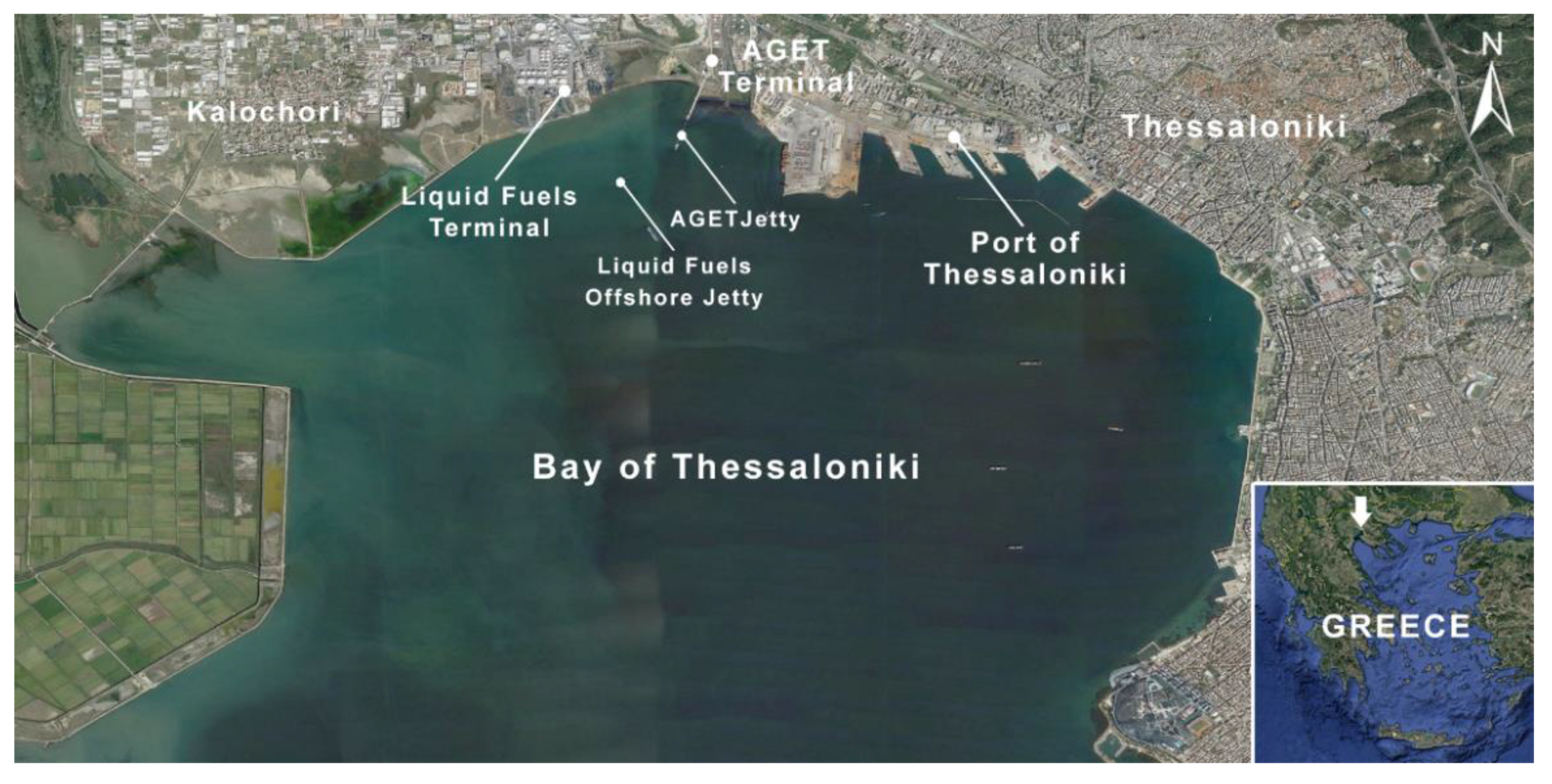
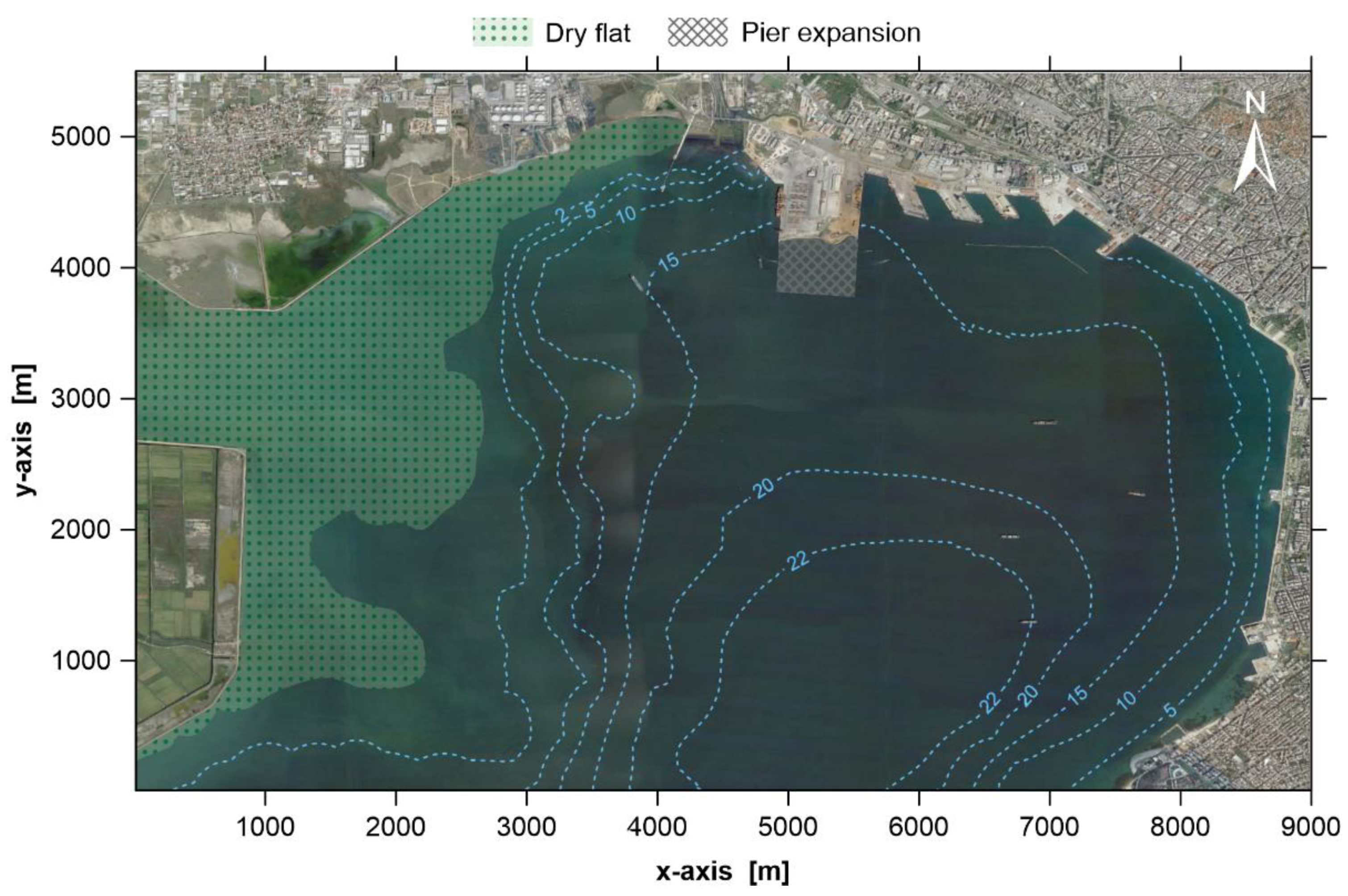
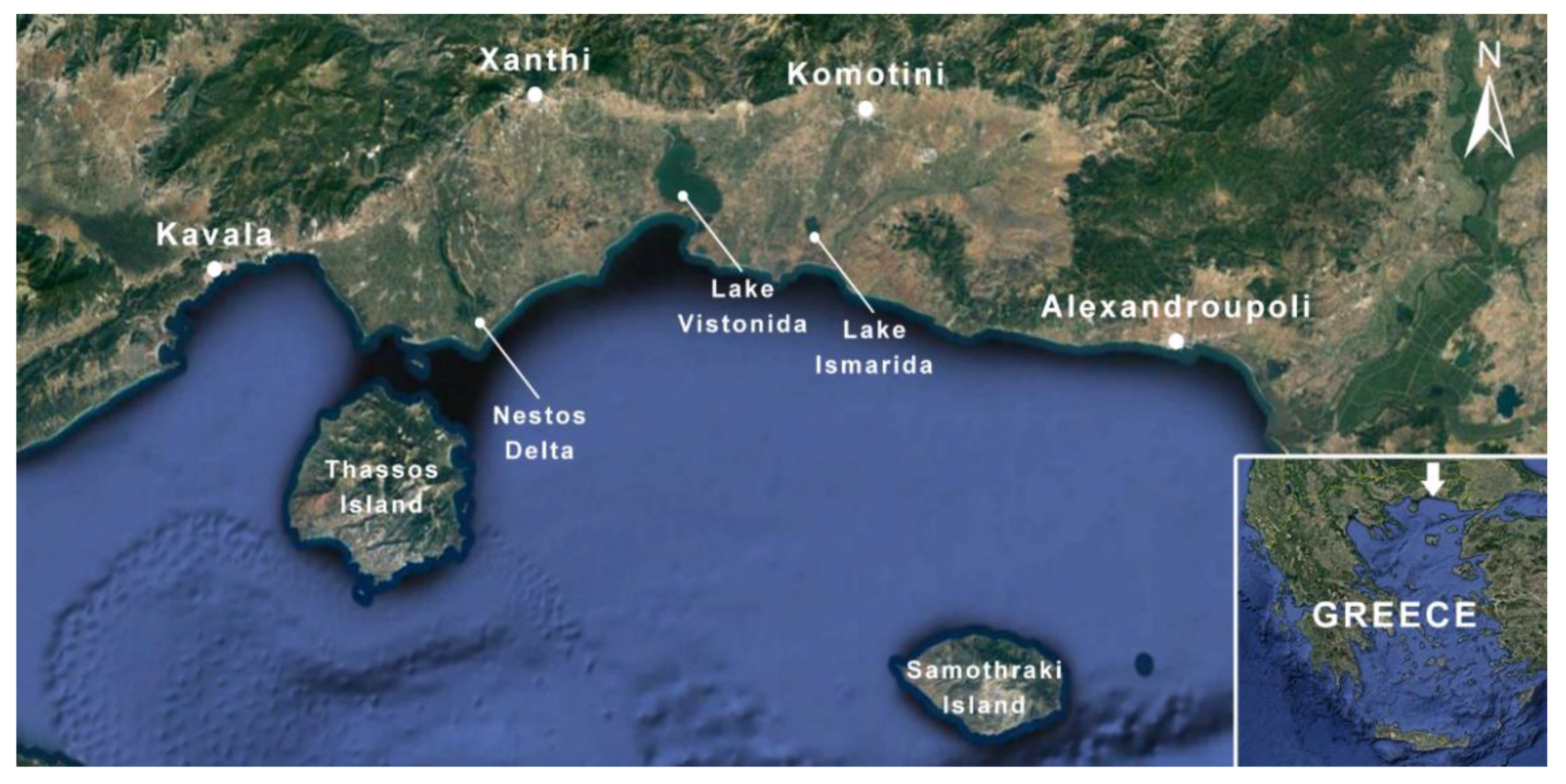
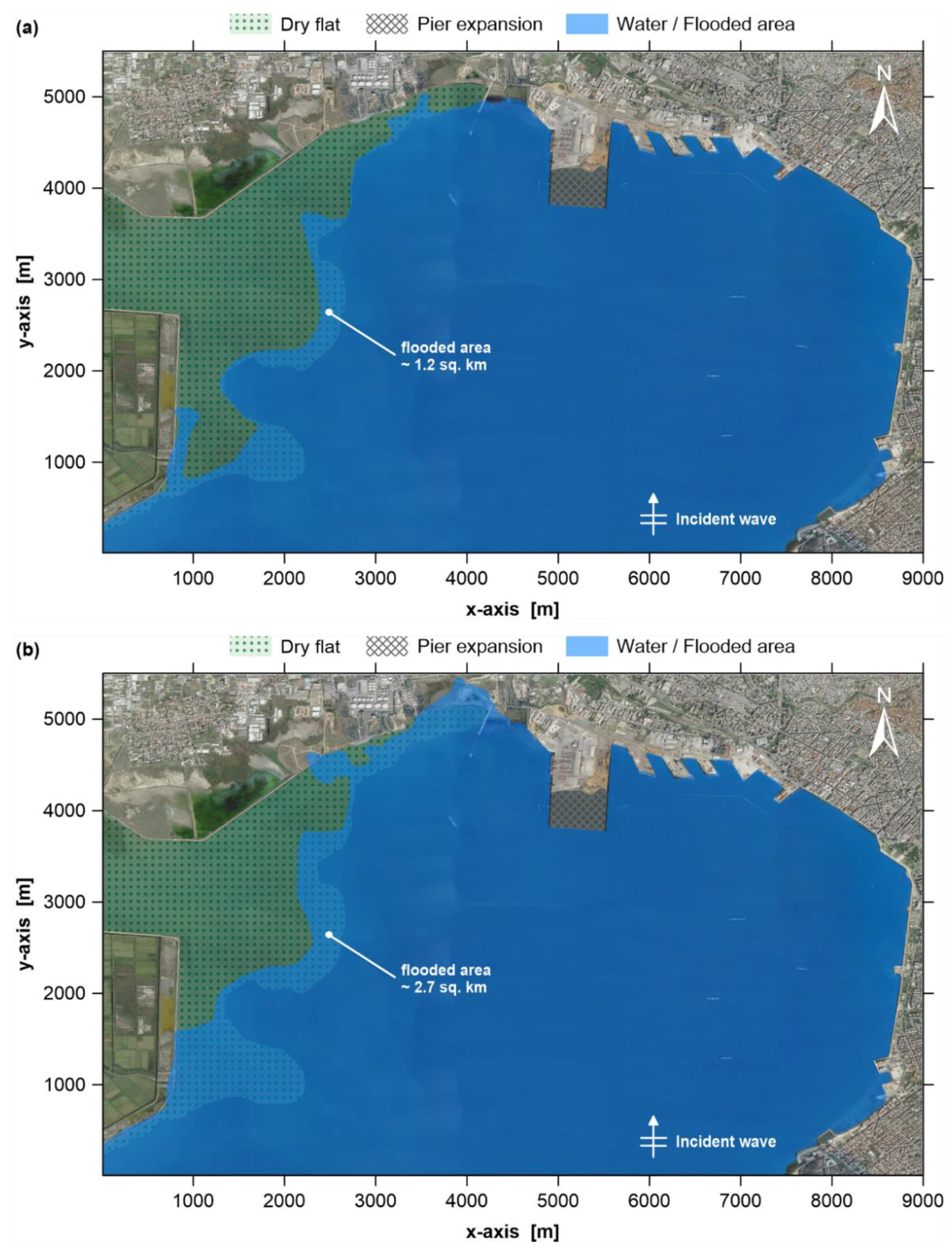


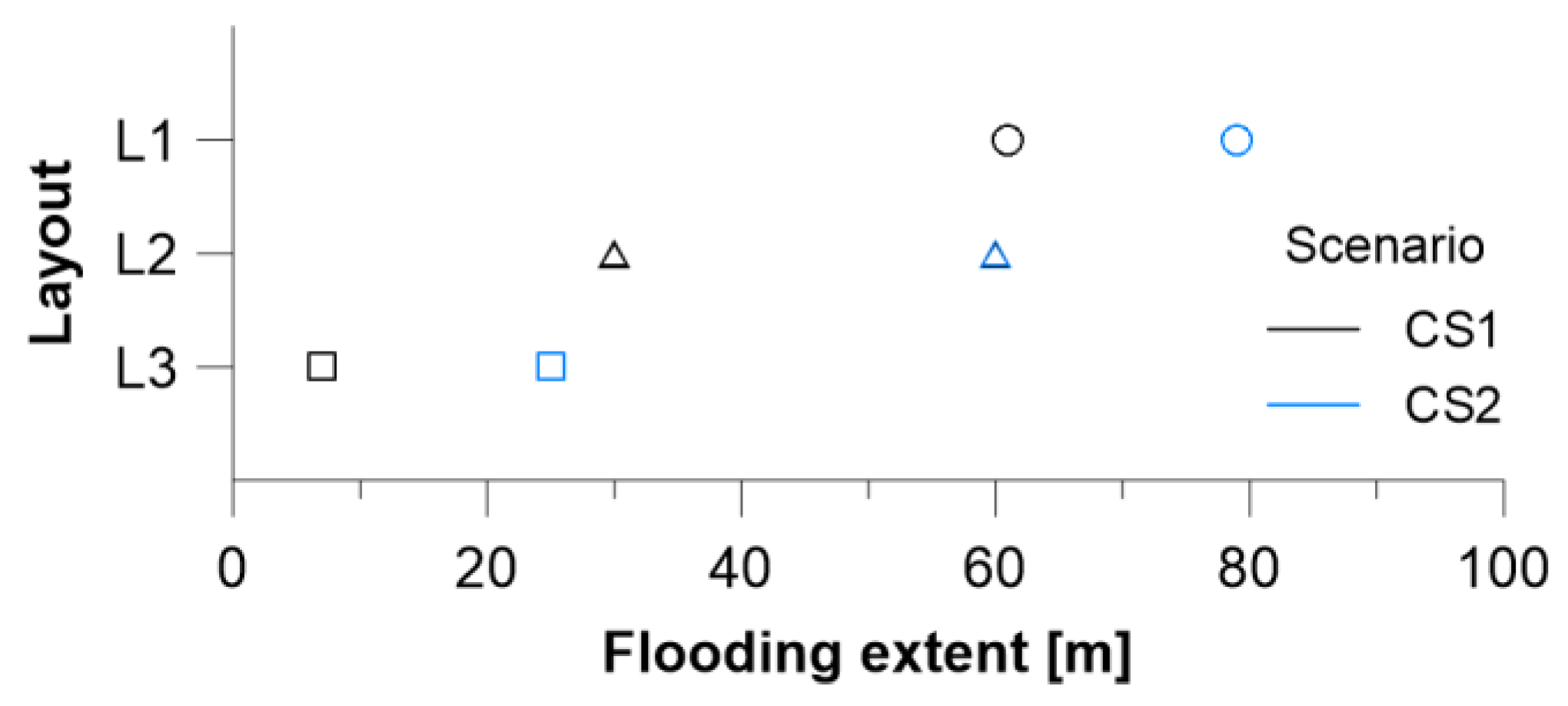
| Test | sop | tanα | ξop | Rc/Hi | B/Hi | Beff/L0 |
|---|---|---|---|---|---|---|
| 1 | 0.02 | 0.4 | 2.83 | 0.25 | 2.5 | 0.075 |
| 2 | 0.50 | 0.100 | ||||
| 3 | 0.75 | 0.125 | ||||
| 4 | 1.00 | 0.150 | ||||
| 5 | 0.04 | 0.4 | 2.00 | 0.13 | 1.3 | 0.075 |
| 6 | 0.25 | 0.100 | ||||
| 7 | 0.38 | 0.125 | ||||
| 8 | 0.50 | 0.150 |
| Scenario | Wave | Storm Surge | ||
|---|---|---|---|---|
| Hs (m) | Tp (s) | Dir (deg) | SSH (m) | |
| LS1 | 1.58 | 4.60 | 0 | - |
| LS2 | 1.58 | 4.60 | 0 | 0.30 |
| Layout | Structure Characteristics | |||
|---|---|---|---|---|
| Type | tanα (-) | Β (m) | Rc1 (m) | |
| L1 | Unprotected beach | |||
| L2 | LCS | 0.4 | 5.0 | 1.0 |
| L3 | Dike | 0.2 | - | 2.0 |
| Scenario | Wave | Storm Surge | ||
|---|---|---|---|---|
| Hs (m) | Tp (s) | Dir (deg) | SSH (m) | |
| CS1 | 5.0 | 8.0 | 0 | - |
| CS2 | 5.0 | 8.0 | 0 | 0.30 |
Publisher’s Note: MDPI stays neutral with regard to jurisdictional claims in published maps and institutional affiliations. |
© 2021 by the authors. Licensee MDPI, Basel, Switzerland. This article is an open access article distributed under the terms and conditions of the Creative Commons Attribution (CC BY) license (https://creativecommons.org/licenses/by/4.0/).
Share and Cite
Samaras, A.G.; Karambas, T.V. Modelling the Impact of Climate Change on Coastal Flooding: Implications for Coastal Structures Design. J. Mar. Sci. Eng. 2021, 9, 1008. https://doi.org/10.3390/jmse9091008
Samaras AG, Karambas TV. Modelling the Impact of Climate Change on Coastal Flooding: Implications for Coastal Structures Design. Journal of Marine Science and Engineering. 2021; 9(9):1008. https://doi.org/10.3390/jmse9091008
Chicago/Turabian StyleSamaras, Achilleas G., and Theophanis V. Karambas. 2021. "Modelling the Impact of Climate Change on Coastal Flooding: Implications for Coastal Structures Design" Journal of Marine Science and Engineering 9, no. 9: 1008. https://doi.org/10.3390/jmse9091008
APA StyleSamaras, A. G., & Karambas, T. V. (2021). Modelling the Impact of Climate Change on Coastal Flooding: Implications for Coastal Structures Design. Journal of Marine Science and Engineering, 9(9), 1008. https://doi.org/10.3390/jmse9091008







